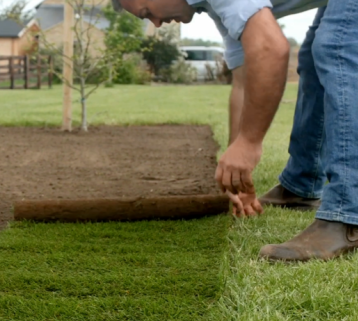
July 14, 2023 Turf Tips
So, you’ve looked at your garden or landscaping project and decided your lawn is looking a little tired. You’ve found George Davies Turf to order your high-quality turf, but then what? How do you turn multiple rolls of turf into a seamlessly smooth lawn? As turf experts, we’ve pulled together everything you need to know when it comes to laying turf.
As long as your soil is not frozen solid or heavily waterlogged, you can lay turf any time of year. The important part when laying new grass is ensuring the soil beneath has been prepared correctly to give the grass roots their best chance to quickly anchor in.
The right type of turf will depend on the conditions of your soil, the purpose of your landscaping project and how much time you have to care for your new lawn. Here at George Davies Turf, we have a range of turf for you to find the best one. Alternatively, read our blog on the different types of turf or contact our team who’ll talk you through the options.
Whether it’s a small domestic garden or a professional football pitch, you need you know the specifications of your project before you can start.
Area measurements – use our handy guide and turf calculator to confirm how many rolls of turf you’ll require.
Is grass already there? – If yes, you’ll need to strip this away and prepare the area before laying new turf.
Your soil type – the type of soil will influence the turf you choose. Our team can help you find the right match.
Completion date – turf is usually the last piece of a landscaping project. Your end date will determine when to book your turf delivery.
Your turf delivery date – once confirmed, make sure you have everything you need and keep an eye on the weather conditions.
Before you lay your first roll of turf, make sure you have the right turfing equipment for a smooth process. The tools you’ll need include:
When you’re replacing an existing lawn, use a turf cutter or shovel to remove the top layer, revealing the soil underneath. If you’re replacing a drive or patio with grass, you’ll also need to remove the top layer, cement and sub-base until you expose soil.
If the area has already been stripped but there’s a weed invasion, use a weedkiller and neutralise the area before applying fresh topsoil or turf. You can lay turf over an existing lawn but it’s not best practice as the roots of the new turf will struggle to penetrate the old lawn.
You want to loosen the soil (about 150mm deep) to give your new turf roots a chance to successfully embed. Use a rotavator or garden fork to turn over the area. The soil should also be free of stones larger than 10mm. Rake the area flat and if you need to increase the height of your new lawn, add a layer of topsoil. Again, rake it flat and gently compact down by using a compaction plate or doing the “Gardeners’ Walk”, where you shuffle your feet along the surface – get the whole family involved with this!
Top turf tip – Avoid using weed fabric or membrane under your lawn. This is a suggested solution to stop weeds but in reality, it stops the new turf from putting its roots down into the soil.

Turf laying involves starting how you would with a puzzle, starting with the edges of your lawn to form a border. This will help stop the size of your lawn from shrinking and moving over time as these tend to be whole pieces of turf.
Next, pick the centre focal point of the lawn from its main viewpoint (i.e., patio doors or steps), and lay a line of turf away from this centre point. Once you reach the other edge, turn around and lay the next row as “return”, in the opposite direction. Aim to stagger the pieces, like a brick wall, to avoid any gaps. Repeat until the area is full to achieve the perfect striped lawn.




Top turf tips:
Make sure you lay at least a quarter of a turf roll. If a piece is going to be smaller, cut it into two so each piece is larger than a quarter. This will help prevent shrinkage.
Place laying boards on the row of turf you’ve just laid; they’ll protect it from leaving footprints or creating hollows. It also helps to gently press the turf down into the soil.
New turf needs watering every day between Feb-Nov, by natural rainfall, sprinkler or hose. The time of year you’re laying turf and the weather conditions will influence how much water your turf requires. A good rule of thumb is each roll of turf needs 3-5 minutes of watering per day – ideally split between the morning and evening.
Questions to ask yourself before watering your lawn:
For more advice, read our blog on how much water a new lawn needs.

George Davies wanted to give you a thorough but easy to follow, step-by-step guide, showing you how to get that professional finish to your project.
He breaks each step down, giving you an idea of what you need to start making your dream garden. There are top tips on how to achieve the very best look for your new lawn.
He talks about instant stripes, watering, and how to measure odd shaped areas because let’s face it, no one has a perfectly uniform square garden!
So, check out the video below on how to lay turf rolls!
Get your garden ready for summer with high-quality turf from George Davies Turf. Our guaranteed delivery slots mean you can have your lawn laid and established before the warm weather hits! Just get in touch.
CALL US NOW ON 01234 818 253